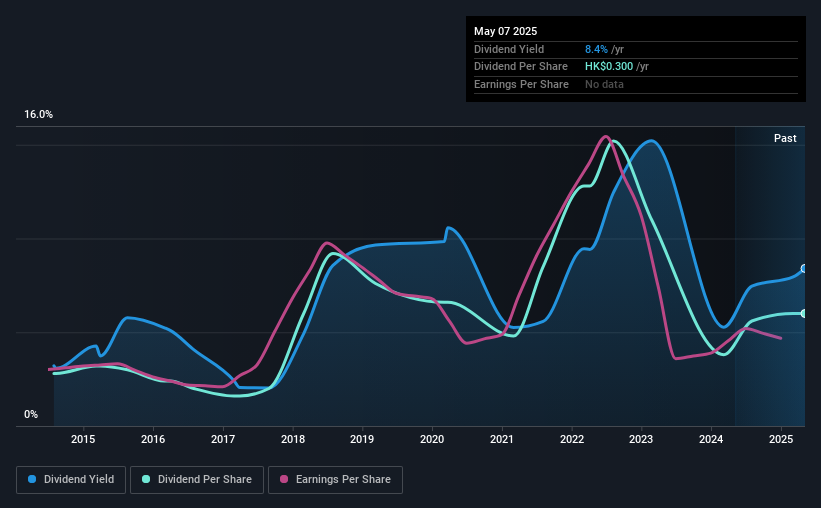
Readers hoping to buy Lee & Man Chemical Company Limited (HKG:746) for its dividend will need to make their move shortly, as the stock is about to trade ex-dividend. The ex-dividend date generally occurs two days before the record date, which is the day on which shareholders need to be on the company's books in order to receive a dividend. The ex-dividend date is important because any transaction on a stock needs to have been settled before the record date in order to be eligible for a dividend. This means that investors who purchase Lee & Man Chemical's shares on or after the 12th of May will not receive the dividend, which will be paid on the 3rd of June.
The company's next dividend payment will be HK$0.15 per share. Last year, in total, the company distributed HK$0.30 to shareholders. Based on the last year's worth of payments, Lee & Man Chemical has a trailing yield of 8.4% on the current stock price of HK$3.57. If you buy this business for its dividend, you should have an idea of whether Lee & Man Chemical's dividend is reliable and sustainable. That's why we should always check whether the dividend payments appear sustainable, and if the company is growing.
If a company pays out more in dividends than it earned, then the dividend might become unsustainable - hardly an ideal situation. Lee & Man Chemical paid out a comfortable 50% of its profit last year. Yet cash flows are even more important than profits for assessing a dividend, so we need to see if the company generated enough cash to pay its distribution. It paid out 79% of its free cash flow as dividends, which is within usual limits but will limit the company's ability to lift the dividend if there's no growth.
It's positive to see that Lee & Man Chemical's dividend is covered by both profits and cash flow, since this is generally a sign that the dividend is sustainable, and a lower payout ratio usually suggests a greater margin of safety before the dividend gets cut.
View our latest analysis for Lee & Man Chemical
Click here to see how much of its profit Lee & Man Chemical paid out over the last 12 months.

Have Earnings And Dividends Been Growing?
When earnings decline, dividend companies become much harder to analyse and own safely. If earnings fall far enough, the company could be forced to cut its dividend. Lee & Man Chemical's earnings per share have fallen at approximately 7.2% a year over the previous five years. When earnings per share fall, the maximum amount of dividends that can be paid also falls.
The main way most investors will assess a company's dividend prospects is by checking the historical rate of dividend growth. In the past 10 years, Lee & Man Chemical has increased its dividend at approximately 7.9% a year on average.
To Sum It Up
Is Lee & Man Chemical worth buying for its dividend? Its earnings per share have been declining meaningfully, although it is paying out less than half its income and more than half its cash flow as dividends. Neither payout ratio appears an immediate concern, but we're concerned about the earnings. Overall we're not hugely bearish on the stock, but there are likely better dividend investments out there.
If you want to look further into Lee & Man Chemical, it's worth knowing the risks this business faces. To that end, you should learn about the 2 warning signs we've spotted with Lee & Man Chemical (including 1 which is a bit unpleasant).
Generally, we wouldn't recommend just buying the first dividend stock you see. Here's a curated list of interesting stocks that are strong dividend payers.
Have feedback on this article? Concerned about the content? Get in touch with us directly. Alternatively, email editorial-team (at) simplywallst.com.
This article by Simply Wall St is general in nature. We provide commentary based on historical data and analyst forecasts only using an unbiased methodology and our articles are not intended to be financial advice. It does not constitute a recommendation to buy or sell any stock, and does not take account of your objectives, or your financial situation. We aim to bring you long-term focused analysis driven by fundamental data. Note that our analysis may not factor in the latest price-sensitive company announcements or qualitative material. Simply Wall St has no position in any stocks mentioned.